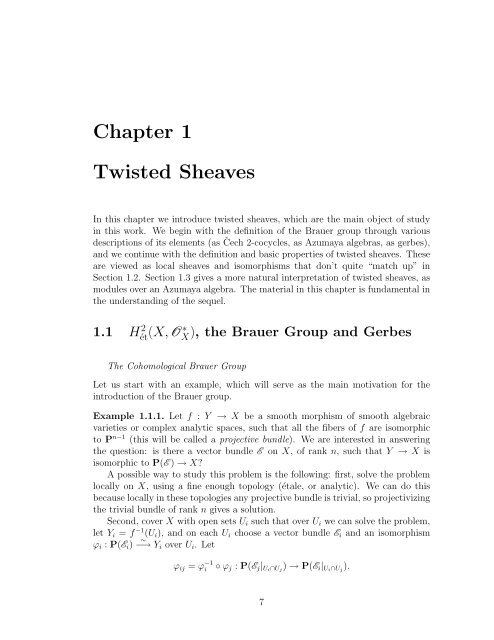derived categories of twisted sheaves on calabi-yau manifolds
derived categories of twisted sheaves on calabi-yau manifolds
derived categories of twisted sheaves on calabi-yau manifolds
Create successful ePaper yourself
Turn your PDF publications into a flip-book with our unique Google optimized e-Paper software.
Chapter 1<br />
Twisted Sheaves<br />
In this chapter we introduce <str<strong>on</strong>g>twisted</str<strong>on</strong>g> <str<strong>on</strong>g>sheaves</str<strong>on</strong>g>, which are the main object <str<strong>on</strong>g>of</str<strong>on</strong>g> study<br />
in this work. We begin with the definiti<strong>on</strong> <str<strong>on</strong>g>of</str<strong>on</strong>g> the Brauer group through various<br />
descripti<strong>on</strong>s <str<strong>on</strong>g>of</str<strong>on</strong>g> its elements (as Čech 2-cocycles, as Azumaya algebras, as gerbes),<br />
and we c<strong>on</strong>tinue with the definiti<strong>on</strong> and basic properties <str<strong>on</strong>g>of</str<strong>on</strong>g> <str<strong>on</strong>g>twisted</str<strong>on</strong>g> <str<strong>on</strong>g>sheaves</str<strong>on</strong>g>. These<br />
are viewed as local <str<strong>on</strong>g>sheaves</str<strong>on</strong>g> and isomorphisms that d<strong>on</strong>’t quite “match up” in<br />
Secti<strong>on</strong> 1.2. Secti<strong>on</strong> 1.3 gives a more natural interpretati<strong>on</strong> <str<strong>on</strong>g>of</str<strong>on</strong>g> <str<strong>on</strong>g>twisted</str<strong>on</strong>g> <str<strong>on</strong>g>sheaves</str<strong>on</strong>g>, as<br />
modules over an Azumaya algebra. The material in this chapter is fundamental in<br />
the understanding <str<strong>on</strong>g>of</str<strong>on</strong>g> the sequel.<br />
1.1 H2 ét (X, O∗ X ), the Brauer Group and Gerbes<br />
The Cohomological Brauer Group<br />
Let us start with an example, which will serve as the main motivati<strong>on</strong> for the<br />
introducti<strong>on</strong> <str<strong>on</strong>g>of</str<strong>on</strong>g> the Brauer group.<br />
Example 1.1.1. Let f : Y → X be a smooth morphism <str<strong>on</strong>g>of</str<strong>on</strong>g> smooth algebraic<br />
varieties or complex analytic spaces, such that all the fibers <str<strong>on</strong>g>of</str<strong>on</strong>g> f are isomorphic<br />
to P n−1 (this will be called a projective bundle). We are interested in answering<br />
the questi<strong>on</strong>: is there a vector bundle E <strong>on</strong> X, <str<strong>on</strong>g>of</str<strong>on</strong>g> rank n, such that Y → X is<br />
isomorphic to P(E ) → X?<br />
A possible way to study this problem is the following: first, solve the problem<br />
locally <strong>on</strong> X, using a fine enough topology (étale, or analytic). We can do this<br />
because locally in these topologies any projective bundle is trivial, so projectivizing<br />
the trivial bundle <str<strong>on</strong>g>of</str<strong>on</strong>g> rank n gives a soluti<strong>on</strong>.<br />
Sec<strong>on</strong>d, cover X with open sets Ui such that over Ui we can solve the problem,<br />
let Yi = f −1 (Ui), and <strong>on</strong> each Ui choose a vector bundle Ei and an isomorphism<br />
ϕi : P(Ei) ∼<br />
−→ Yi over Ui. Let<br />
ϕij = ϕ −1<br />
i ◦ ϕj : P(Ej|Ui∩Uj ) → P(Ei|Ui∩Uj ).<br />
7
















